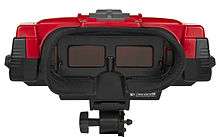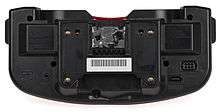Virtual Boy hardware
The Virtual Boy hardware includes the console as well as a variety of accessories. The Virtual Boy is Nintendo's first 32-bit system.[1]
The Virtual Boy system uses a pair of 1×224 linear arrays (one per eye) and rapidly scans the array across the eye's field of view using flat oscillating mirrors. These mirrors vibrate back and forth at a very high speed, thus the mechanical humming noise from inside the unit. Each Virtual Boy game cartridge has a yes/no option to automatically pause every 15–30 minutes so that the player may take a break.
One speaker per ear provides the player with audio.[2]
Display

The Virtual Boy was the first video game console that was supposed to be capable of displaying "true 3D graphics" out of the box, in a form of virtual reality. Whereas most video games use monocular cues to achieve the illusion of three dimensions on a two-dimensional screen, the Virtual Boy creates an illusion of depth through the effect known as parallax. In a manner similar to using a head-mounted display, the user looks into an eyepiece made of neoprene on the front of the machine, and then an eyeglass-style projector allows viewing of the monochromatic (in this case, red) image.
The Virtual Boy, which uses an oscillating mirror to transform a single line of LED-based pixels into a full field of pixels. Nintendo claimed that a color display would have made the system too expensive and resulted in "jumpy" images, so the company opted for a monochrome display.[1] To achieve a color display, Nintendo would have used a combination of red, green, and blue LEDs. At the time, blue LEDs were still considerably expensive and would in turn raise the price of the final product. This in combination with the other drawbacks helped influence Nintendo's decision to release the Virtual Boy as a monochrome device.
Control
The Virtual Boy was meant to be used sitting down at a table,[3] although Nintendo said it would release a harness for players to use while standing.[1]
The Virtual Boy, being a system with heavy emphasis on three-dimensional movement, needed a controller that could operate along a Z axis. The Virtual Boy's controller was an attempt to implement dual digital "D-pads" to control elements in the aforementioned 3D environment. And, until the Nintendo 3DS's Circle Pad Pro accessory was released, the Virtual Boy was Nintendo's only handheld that had a second directional input.

The controller itself is shaped like an "M" (similar to a Gamecube controller). One holds onto either side of the controller and the part that dips down in the middle contains the battery pack. There are six buttons on the controller (A, B, Start, Select, L and R), the two D-pads, and the system's "on/off" switch. The two directional pads are located on either side of the controller at the top. The "A" and "B" buttons are located below the pad on the right side and the "Start" and "Select" buttons are located in the same spot on the left side. What would normally be called "shoulder buttons" ("L" and "R") are located behind the area where the pads are, on the back of the controller, functioning more as triggers.
In more traditional 2-dimensional games, the two directional pads are interchangeable. For others with a more 3D environment, like Red Alarm, 3D Tetris, or Teleroboxer, each pad controls a different feature. The symmetry of the controller also allows left-handed gamers to reverse the controls (similar to the Atari Lynx).
One of the unique features of the controller is the extendable power supply that slides onto the back. It houses the six AA batteries required to power the system. This can be substituted with a wall adapter, though a "slide on" attachment is required for the switchout. Once the slide on adapter is installed, a power adapter can be attached to provide constant power.
Connectivity

During development, Nintendo promised the ability to link systems for competitive play.[4] The system's EXT (extension) port, located on the underside of the system below the controller port, was never officially supported since no "official" multiplayer games were ever published, nor was an official link cable released. (Although Waterworld and Faceball were going to use the EXT port for multiplayer play, the multiplayer features in the former were removed[5] and the latter was canceled.)
Specifications
| Processor | Customized NEC V810 (NVC, P/N uPD70732) 32-bit RISC Processor @ 20 MHz (18 MIPS) 1 KB instruction cache |
|---|---|
| Memory | 128 KB dual-port VRAM 128 KB of DRAM 64 KB WRAM (PSRAM) |
| Display (× 2) | Reflection Technologies Inc. SLA Model P4 – monochromatic red, LED display 384 x 224 pixel resolution (produced by mechanically scanning each 1 × 224 LED array) Four simultaneous shades per 4-pixel column (black + 3 red, of approximately 128 levels of intensity) 50 Hz[6] double-buffered frame rate |
| Power | 6 AA Batteries or 10VDC at 350mA AC Adapter/Tap (third-party Performance Adaptor DC 9V 500mA) |
| Sound | 10-bit Stereo |
| Controller | 6 buttons and 2 D-pads uses NES controller protocol |
| Serial Port | 8 pin cable with 8-bit serial transfer |
| Hardware Part Numbers | VUE-001 Virtual Boy Unit VUE-003 Stand VUE-005 Controller VUE-006 Game Pak VUE-007 Battery Pack VUE-010 Eyeshade VUE-011 AC Adapter Tap ("Use With Super NES AC Adapter No. SNS-002 Only") VUE-012 Eyeshade Holder VUE-014 Red & Black Stereo Headphones |
| Weight | 750 grams |
| Dimensions | 8.5"H × 10"W × 4.3"D |
Cartridge
| 128 megabit addressable ROM space (4–16 megabit ROM used in released games) 128 megabit addressable RAM space (0–8 kilobyte Battery Backed RAM in released games) 128 megabit addressable expansion space (unused in any released games) CPU interrupt available from the cartridge Left and right audio signals pass through cartridge 60-pin connector |
References
- 1 2 3 KEVIN RAFFERTY, IN T. "Super Mario Takes Leap into Three Dimensional Space." The Guardian (pre-1997 Fulltext): 0. Nov 16 1994. ProQuest. Web. 8 July 2013.
- ↑ Powell, Doug. "A Virtual Backlash." Computing Canada Dec 21 1994: 1,1,4. ABI/INFORM Global. Web. 24 May 2012.
- ↑ By JOHN MARKOFFSpecial to The New,York Times. "Nintendo Counts on a New 'Virtual' Game." New York Times (1923-Current file): 2. Nov 14 1994. ProQuest. Web. 8 July 2013.
- ↑ Rafferty, Kevin. "Super Mario Takes Leap into Three Dimensional Space." The Guardian (1959-2003): 2. ProQuest Historical Newspapers: The Guardian (1821-2003) and The Observer (1791-2003). Nov 16 1994. Web. 24 May 2012.
- ↑ http://www.vr32.de/modules/interviews/?3
- ↑ Guy Perfect (2013-01-04). "Virtual Boy Sacred Tech Scroll - Virtual Boy Specifications". Retrieved 2013-01-21.